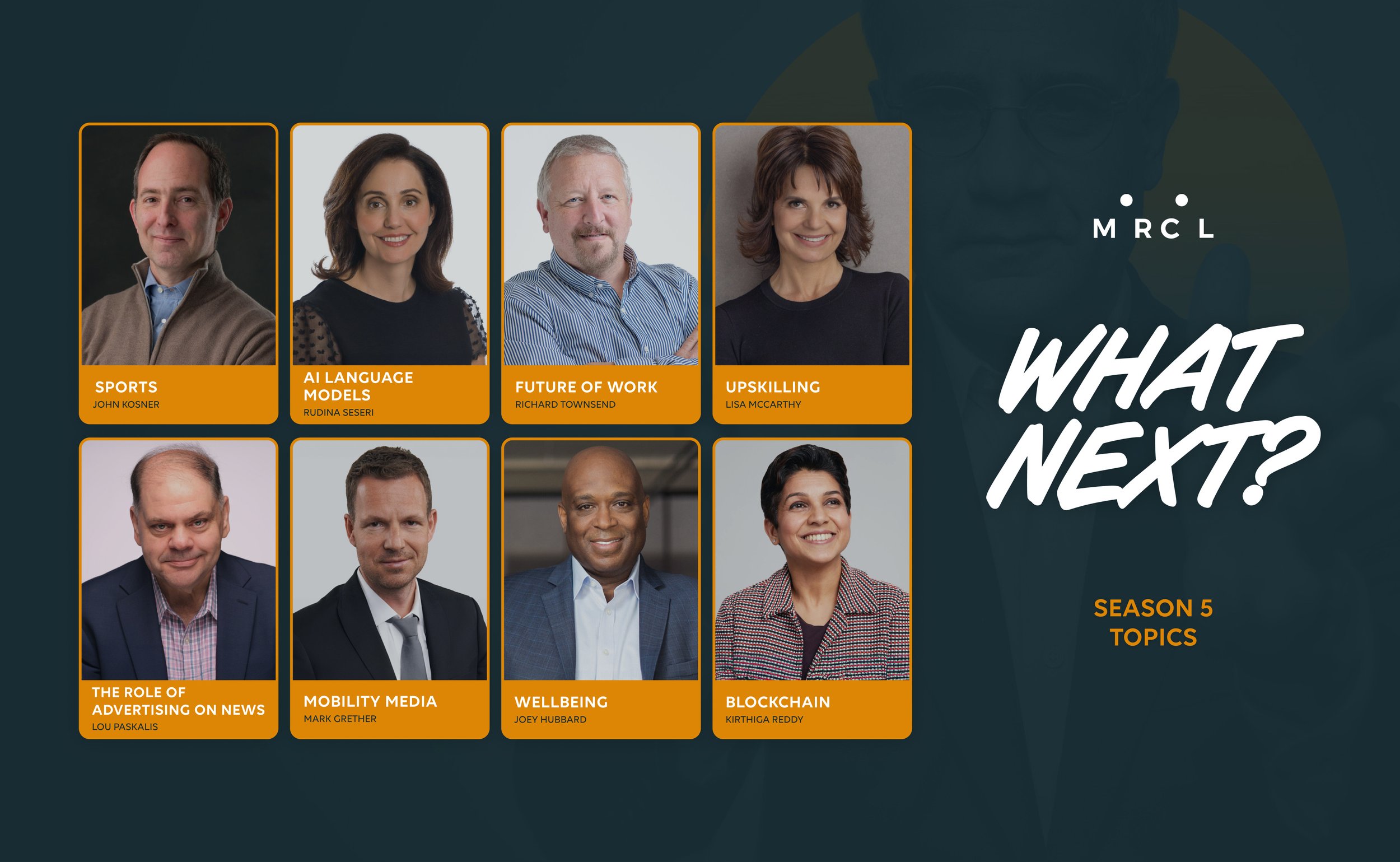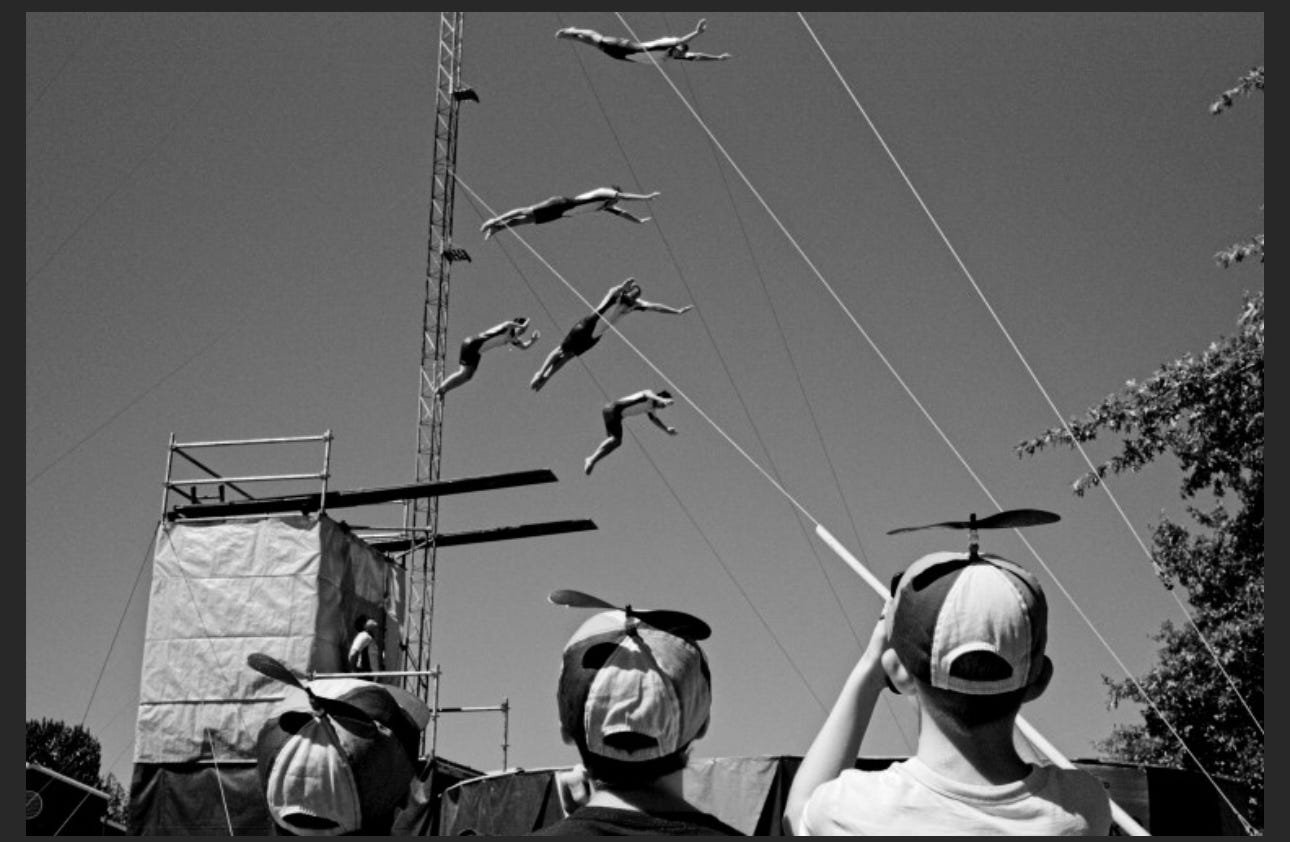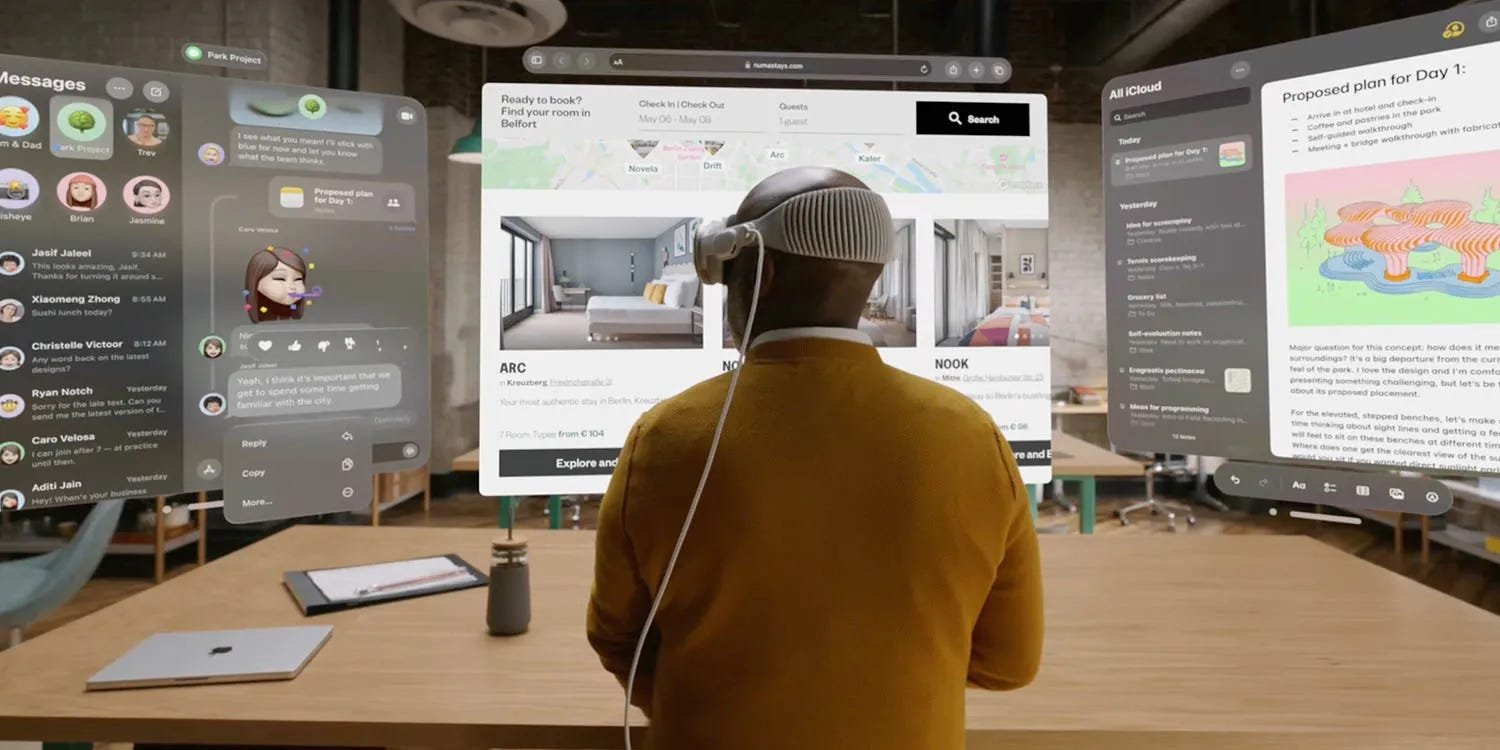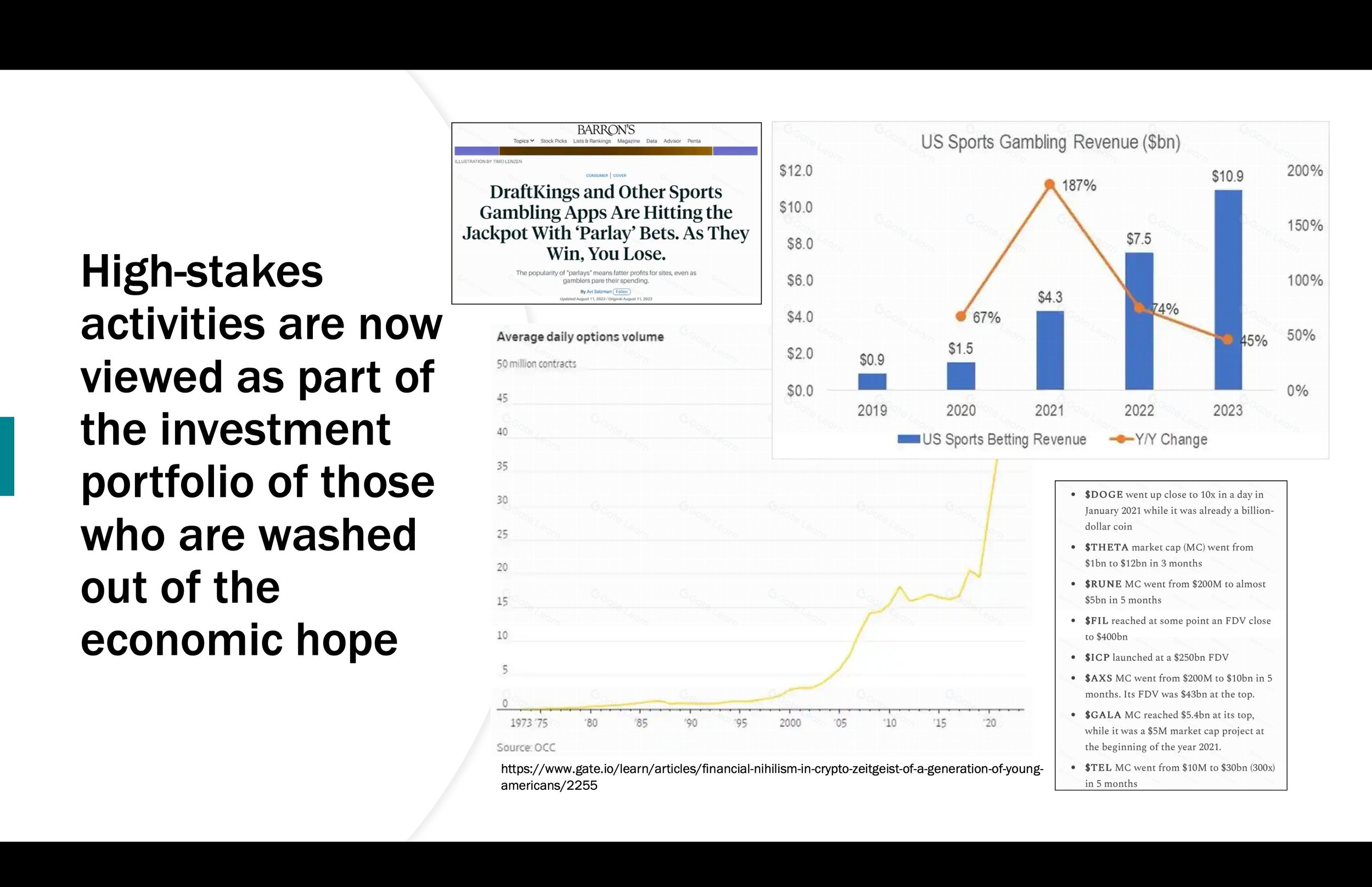8 Perspectives on What Next?
We all wonder “what next?” since we will spend the rest of our lives in the future.
How can we best understand key trends and the opportunities and challenges tomorrow will bring?
What can and should we do to position ourselves, our teams and our businesses in a way that allows us to thrive?
One way is to ask a range of world class individuals who marry expertise, craft, bravery, risk-taking, passion and a track record of pioneering across a wide spectrum of subjects and areas, about what they believe is next in their fields.
Over the past four years I have spoken to over 100 talented people across the world who have made their mark in the arts, business, culture, science, technology and much more asking them for the three biggest things they see coming next that everyone should pay attention to.
These conversations are professionally recorded, distilled, edited and supported by a world class team working across three continents at the Publicis Groupe which then make it available completely free (no subscription fee and no advertising or promotion) on every major podcasting platform across the globe (and to all 106,000+ Publicis Groupe employees via the internal Marcel platform.)
You can find the conversations on Apple here:
You can find the conversations on Spotify here:
8 Perspectives from Season 5.
We record 24 shows each year in three seasonal bursts of 8 episodes.
This season of 8 shows reflects the range of guests and subjects which makes this show unique in that it does not focus on a subject, a country, an ideology or a technology.
We do not even have a well-defined “target audience”!
Just humans who want to learn and grow and ensure a better future.
So the conversations focus on helping people see, feel and think differently about how they can grow themselves, their teams and their business.
The goal is to have the listener come away with accelerated insights, actionable inspiration and a feeling that the guest helped them augment intelligence.
AI’s of a different type than the AI we are all preparing for.
Here is a very small sampling of perspectives from each of the 8 people we were privileged to speak with this season ( You can find all these 8 episodes plus the first 2 of the next season and dozens of other conversations on your choice of a podcast platform by typing in “What Next? Publicis Groupe”).
Listen to any one and it will open your mind. Listen to all eight and you will be significantly better off as a person and a professional. Your “what next” will likely be an upgraded version of you before you heard “What Next?”
1. John Kosner on the Future of Sports
John Kosner is the President of Kosner Media, a digital media and sports consultancy and an investment advisor to sports tech startups on the future of sports.
His four decades of expertise include building ESPN into the world's leading digital sports destination; he also struck ESPN's original streaming deal with Bamtech, which led to Disney's acquisition of Major League baseball's technology firm in 2016.
In a world where sports is dominating media and fusing with gaming anybody interested in business should listen to it (even if you are the rare bird who does not follow sports.)
John argues that sports will follow gaming into the interactive world building communities around sports players online and offline as younger fans look for new ways to engage.
He advises us to follow his old Disney colleague, Steve Jobs’ mantra: “beware the status quo” in a world where everything including sports is being re-imagined.
John explains why integrity and trust will be key in a world of sports as AI and sports betting scale.
2. Rudina Seseri on AI Language Models
Long before AI was cool Rudina Seseri, Co-Founder and Managing Partner of Glasswing Ventures was investing in the space. Amidst the hysteria about AI it is great to hear a deeper, more reasoned and seasoned perspective on AI from someone with 19 years of investing and operational experience in high-growth AI and Frontier Technology companies.
Rudina argues that large language models will become smaller, more distilled, more refined, and therefore more powerful, while the transparency of the open-source and open model landscape will enable companies to control their own destinies.
Rudina also believes that the Coming Wave, predicted by author Mustafa Suleyman, will strip the paint off some AI companies to reveal the true AI-Natives set to thrive.
3. Richard Townsend on The Future of Work
Richard Townsend is CEO Workforce Learning at QA which delivers learning programs to some of the greatest companies in the world shares insights on how Al is going to create better humans.
He shared how the key is to get companies to adapt work and organization to AI versus just adding skills and expertise.
How a growth mindset and learning organization will combine AI, data and the cloud in new ways to augment humans.
Augmented Humans is a profound idea.
And ultimately that is where real productivity starts to happen.
4. Lisa McCarthy on Up-skilling.
Lisa McCarthy is the CEO and co-founder of The Fast Forward Group, a training and executive coaching company that gives people a proven approach to think big, manage stress and achieve success and fulfillment in their whole life.
Prior to starting Fast Forward, Lisa spent 25 years at prominent media companies Univision, Viacom and CBS leading sales organizations responsible for billions in revenue.
Lisa shares how to help teams overcome the toll of high-pressure, always-on workplaces where people feel professional success requires personal sacrifice.
Lisa explains that there will continue to be a significant war for talent and leaders are already learning that they will benefit more from up-skilling the people they have versus trying to get external talent that may or not make it in terms of onboarding.
5. Lou Paskalis on the Role of Advertising on News.
Lou Paskalis is Chief Strategy Officer of Ad Fontes Media, CEO and founder of AJL Advisory. Lou is a former president and chief operating officer of MMA Global and was a senior marketer at Gallo, American Express and Bank of America.
Lou frames and explains the business opportunity that the return to News represents for marketers which also has the added benefit of bolstering our society. He discusses why the unfounded fears of becoming collateral damage in the culture wars has sidelined many advertisers and deprived news publishers of a valuable source of advertising revenue at a time when they are actively combating disinformation and misinformation in a growing war on truth.
Lou notes that as AI becomes mainstream, the proliferation of misinformation it could create will exacerbate what we are already seeing today. Some bad actors will introduce "deep-fakes" that will be harder for consumers to discern and technology to detect. These ultimately threaten everything from the way business gets done to our society and indeed, democracy itself.
But at the same time, AI will help news publishers hone the appeal of their core product by helping them easily and efficiently tailor their offerings to disparate audiences.
There are big opportunities for savvy marketers to partner with news publishers by investing in news advertising and enabling new technologies to bring both news and their messages forward to grow their business.
6. Mark Grether on Mobility Media.
Mark Grether today runs Uber's advertising business in over 30 markets. He also sold Sizmek to Amazon and was the one of the architects of WPP's Xaxis.
Mark explains why we are in the renaissance of marketing and it is not that CMO's are being eliminated but rather they are being elevated as marketing becomes the growth driver in this new age.
Mark predicts there will be many more platforms ( Like Uber, Walmart Connect and much more) as companies realize they are in a B To C business ( products and services to consumers) and a B to B ( data monetization for partners and companies) business.
How mobility media is joining mobile media to create a new palette of opportunities, businesses and experiences for people because knowing where someone is and where they are going is as important as who they are. And why soon the car may be another living room and the auto companies will be huge ad sellers at Cannes selling their connected (tv and other) experiences.
How online and offline, above the line and below the line and much more are fusing and why fusion is the path forward from confusion.
Why businesses have always used machine learning in media to find the right person at the right place and the right time but AI will allow one to craft the right creative.
7. Joey Hubbard on Wellbeing.
Joey Hubbard has worked with Tiger Woods, Kobe Bryant and many leaders before becoming the Chief Training Officer at Thrive Global which he co-founded with Arianna Huffington.
Joey believes a key to the future is to be resilient and understand why looking after your and your team's well-being is critical.
One has to be well. To lead well.
Joey shares provocative insights into how to thrive given the pressures of today including
a) why workplaces mandating RTO need to offer something to “earn the commute”.
b) taking care of yourself is the least selfish thing you can do!
c) the power of tiny habits which we can leverage right away.
8. Kirthiga Reddy on Blockchain.
Kirthiga Reddy was the first employee of Facebook in India. She is a transformative leader, pioneering engineer, advocate for fairness/opportunity and also a hugely successful leader at Meta/Facebook, first female investment partner of Softbank, co-founder of Liftery and now the CEO and Co-Founder of Generative AI and Blockchain start up Virtualness.
In this conversation, Kirthiga discusses the enabling opportunities provided by Blockchain, Generative AI, and the rise of India.
Kirthiga argues that in the world of Gen AI, blockchain is going to become even more important for creators, brands, sports media, and entertainment.
Kirthiga believes that the read-write-own era that blockchain ushers will give individuals including many who have never had the ability to leverage their talent new ways to monetize their side hustles (and also main hustles) and help bring forth a fairer and more creative world.
She envisions a future where all moments that matter — including awards, certificates, memorabilia -- will be on blockchain.
And if these are not enough you can hear the first two episodes of Season 6 where Sophie Williams a former leader at Netflix speaks about the need for more senior women and John Winsor an executive in residence at Harvard Business School shares thinking about being open and about talent in the cloud.
Or hear episodes about Managing Gen Z from author Heather McGowan or how to best give and receive feedback from executive coach Kim Scott. Or hear about about risk taking, failure, trust and continuous re invention from the legendary Maurice Levy.
Coming soon the future of law, cancer care, and much much more.
All subscription and commercial free and accessible on every major platform in the world.
Click here for access to all the episodes of “What Next?”on Spotify
And here for access to all the episodes of “What Next?” on on Apple
The Age of De-Bossification.
In many industries particularly “White-collar” ones the era of “bosses” is in decline.
There is a rise in the need for leaders, guides, coaches, mentors, role-models, creators, and builders.
Less of a clamoring for bosses, managers, controllers, monitors, evaluators, and paper pushers.
This shift has been driven by changing demographics, the spread of technology, the rise of unbundled and distributed work, new behavior expectations, and a re-definition of what “work” is including the rise of fractionalized and free-agent talent who work for themselves or at multiple jobs and are expected to comprise most of the work force in the US by the end of the decade.
How to a “de-bossify “ourselves or help others do so and therefore adapt from being a “boss” to a “leader”?
Step 1: Be Aware of Bossy Traits!
All of us have both worked for and in times of pressure we ourselves have displayed one or more of these “bossy” traits:
1. THE NARCISSISTIC GOD. These bosses believe that only they know the answer, only they are capable of handling the major meeting, and only they should get the credit for their teams’ success. They often believe they transcend the company. In many instances, they create a godlike cult that worships their every move, using public relations and social media to spread the word.
2. THE MICROMANAGING FIDDLER. These folks are terrific operators—they know how to get things done—but as managers, they retain their obsessive detail orientation. They tell their people what to do and insist they check in with them at every stage. They are insecure and can’t let go of anything. They often manage via spreadsheets or the need for slavish following of systematic procedures.
3. THE OSCAR ASPIRANT. These types emote, loudly and dramatically. Erratic and unpredictable, they are a roller coaster of emotions. They greet bad news with histrionics and good news with hyperbole.
4. THE SCHEMING SPHINX. This is the person who smiles, blows air-kisses and oozes charisma and friendship, says nor shares anything substantial, while sucking up as much information and probing for vulnerabilities. A blend of insecurity and bully juice wrapped in a blanket of charm while oozing calm and friendliness.
5. THE DOUBLE-CROSSING ASSASSIN. While the previous four types are expressive (or anti-expressive in the case of the Scheming Sphinx) in their terribleness, Assassins are soft-spoken, well-behaved, and self-controlled. Behind closed doors, however, they take credit for other people’s work, create animosity by speaking ill of people to others, and find ways to trip up others and make them fail.
Step 2: Understand why the old model is collapsing.
Once upon a time a manager controlled the flow of information, access to opportunities and was a font of expertise and craft.
Today the half-life of knowledge is growing shorter and shorter and the “way of this is the way things were done” is often the opposite of what needs to be done as new competitors and customer expectations do not care a fig about the way it was or is.
AI will turbo-charge this change in ways deeper and faster than anyone of us can even comprehend as the cost of knowledge goes to zero and enables talented individuals to combine, re-combine, scale and re-invent in new ways.
Talent can find information, opportunity, and knowledge at a click of a mouse, a sharply written prompt or the pinch of a finger.
The unbundling and distribution of where and when we work has just begun and culture, teams and excellence will need to be cultivated across time and space with limited in-person interaction as the age of AI, Web 3, XR will make working anywhere and everywhere increasingly the default state in white collar industries making old-fashioned monitoring, controlling, and overseeing difficult.
Step 3: Understand New Leadership.
Modern leadership is about zone of influence versus zone of control.
People follow people and not titles.
Leadership is a role and not a job title.
It is a way of being infused with a passion for excellence and a quest for middle to long term multi-stakeholder growth (company, community, employee, leader) versus a focus on the short term and emphasizing only investors/owners.
It is the ability to communicate and motivate in person and across space. To tattoo moments and make the most of every interaction. To inspire, guide, mentor, build, empathize and unleash.
Most importantly it is about the continuous feedback and learning of a growth mindset.
Step 4: Transforming from boss/manager to leader/coach.
As times change the best managers adapt and learn and flex into new shapes and learn new skills. Transformation is possible for those who care to try.
Just because someone has bossy traits and was forged in a different era does not mean they cannot re-invent and re-wire their skills if they want to.
This transformation requires three conditions:
First it requires today’s bosses to accept that to grow and remain relevant they will have to change and while it may be difficult it is better than becoming irrelevant.
Second it requires their leaders to ensure that new incentive systems that are more about zone of influence, growth of craft and people versus zone of control of budgets and team size are put into place.
A new way requires new pay.
Third there is an urgent need for coaching and training and patience to help today’s managers become tomorrow’s leaders.
A personal hunger supported by new incentives and buttressed with training including the opportunity to self-learn is the formula.
Talent is short and it is a mistake to believe that seasoned employees cannot grow into new potential.
New brooms sweep clean but old brooms know the corners.
The 3 Relevances.
Photography by Felicia Perretti
Change sucks.
But irrelevance is even worse.
Today most firms, institutions and individuals are grappling with 3 levels of relevance.
Does my firm have a relevant business model for the future?
Does my company have the relevant organizational structure, talent mix and suppliers/partners to succeed tomorrow? 3.
Do we as leaders and practitioners have relevant skills and expertise to navigate the transformed world ?
Photography by Felicia Perretti
Relevant business models.
A case can be made that every company needs to interrogate its business model given the changes in technology, demographics and mindsets.
When a company finds itself in trouble it tends to be for two reasons:
Culture: A cultural breakdown due to some combination of a toxic environment, outmoded incentive models or inappropriate leadership. ( Boeing today, Wells-Fargo some time ago).
Competition: An existential crisis driven by a new different economic or distribution model that usually emerges from outside its category definition or usual competitors. ( Tesla and Uber challenges to established auto-makers, linear networks challenged by streaming.)
This culture and competitive soup is now being stirred robustly by AI, Block-chain and XR.
Today AI is driving the cost of knowledge to zero and changing the economics of everything from protein folding to content creation. It is also enabling individuals and small companies to gain scale and capabilities for a few hundred dollars a month that match those of many large companies in an increasing number of areas.
At the same time Blockchain is both creating new ledgers of trust but also allowing creators to own and watermark their work in a world where large tech companies have taken most of the profits and modern AI models are training on their IP.
Upcoming breakthroughs in XR ( Augmented Reality, Virtual Reality, and Spatial Computing) will change communication, creativity and collaboration dramatically within the next three years or less. ( Apple Vision Pro is a threat to any TV manufacturer once its price declines in a few years.)
Smart companies and leaders are re-thinking their business model in various ways including:
a) Blank Sheet Approaches: Working with their internal teams and partners and consultants to re-imagine their business if they were starting today. If they were to begin our company today to satisfy the needs of their customers how would they do it?
b) Attack Mode: If they were to bring their company to its knees as a next age competitor with no legacy constraints but just legal and scientific constraints what would they do?
World class talent and companies never get defeated. They defeat themselves by placing constraints that only exist in their mind or culture or current business models.
Photography by Felicia Perretti
Relevant structures and systems.
The future does not fit in the containers of the past.
Most incentive plans are often optimized to deliver today rather than ensure tomorrow.
In a high velocity and fluid world, partnering and openness rather than control and closed systems are likely to thrive.
Three approaches are often used to re-think structures and systems:
a) Multiple Models: World class companies and leaders run schizophrenic models that have teams focussed on today as well as having teams focussed on tomorrow. These teams often with completely different structures, incentive plans and timelines. While major talent is focussed on today, quite a few world class players in the company are allocated to tomorrow and incentivized to deliver tomorrow’s vs legacy metrics.
b) New Incentive Systems: Firms that have incentives, talent and power structures focused primarily on current delivery while claiming to be future forward should not be taken seriously. Incentive plans, talent allocation and organizational structure drive tomorrow and not strategy decks, flurries of press releases or the announcement of future 20xx task forces.
c) Wider Eco-systems: The best leaders have also begun to re-design the eco-system and architectures of their companies. Many have started to partner aggressively to quickly scale talent while ensuring flexibility looking across wider horizons to ensure both relevance and access to technology. (Microsoft has embraced Linux, partnered with Open AI and long ago dropped the Windows operating division.)
Photography by Felicia Perretti
Are we still relevant?
Companies do not transform people do.
A company remains relevant if its people and leaders remain relevant.
Today anyone who began work less than five years ago needs to find a way to both learn new capabilities but also unlearn some old habits.
This is particularly true for senior leaders with many decades of experience.
The way it was is not the way it is and definitely not the way it will be.
Change is coming much faster than we can hope to retire.
These changes are not just technological, but need to incorporate new mindsets of talent, different economic models and an expectation for leaders and companies to deal with political and social agendas whether they wish to or not.
The key to remaining relevant in the future is to upgrading our mental operating systems.
Leaders everywhere are embracing the new way through a combination of experimenting and using modern technology, hiring coaches, being reverse mentored, partnering with academia and schools and connecting with other leaders to share best practices on learning.
The best companies are also re-allocating dollars to training and learning and mandating up-skilling.
Twisting ourselves into new shapes takes time and practice and can hurt.
It is like going to the gym. Initially difficult and painful.
Some keys to remaining relevant followed by world class talent and leaders.
a) Learning: Leaders today allocate 5 to 10 hours a week to learn and they allocate at least a fifth of their time to think about and re-imagine their firms for tomorrow. If leaders only spend their time on today they realize that their company will not be taken to tomorrow. It is no longer enough to be up to date. One must ensure our teams and skills are up to tomorrow.
b) Monitoring:Leaders watch where top talent from schools are going or where VC and PE money is being driven.
c) Stepping out of comfort zones and category definitions: Tomorrow has already happened elsewhere.
“The future is already here- its just not very evenly distributed” William Gibson
Too many people go to the same industry conferences which are often nothing but incestious gatherings that generate still-born ideas. Best to leave the rote and familiar that feels like Ground Hog day and go to conferences or events of other industries or in other countries.
Regardless of what each of us do we need to address the 3 relevances regarding the future since our firms, our teams, and ourselves are going to spend the rest of our lives there…
Being Better
Peuple basque, Bilbao. Pierre de Vallombreuse,
Often we are told that to succeed one has to be “hard core”.
To be “tough as nails” and be “messianic in mission”.
To strut and take a stance that projects “dominant presence.”
To show no weakness and to “go for the kill”
While sometimes these approaches may work there may be a better way.
To be generous. To be kind. To treat people with dignity.
Reflection. Jhu Ziabin.
Generosity as Strategy.
If strategy is future competitive advantage, generosity is smart for individual or company strategies.
Generosity builds good will which is both an asset and a moat.
It is an asset in that it can be tapped in the future.
It is a moat because when an individual or a company has been generous in times of trouble their employee or customer are less likely to switch to a different firm for a lower price or higher pay.
Generosity is also a key differentiator in that usually when a person or firm needs help there are few people willing to help someone out of power or in trouble. Those individuals and brands who do help stand out and their showing up and helping when others are not burns into the emotional and mental memory of the recipient.
Emotional connections are harder to sever or replace than financial connections.
A story shared with me:
“Long ago, must be 30 years ago or more, I went into Tiffany’s to purchase one cufflink.
The night before I had attended a black-tie event and one cufflink must have worked itself free (it was the solid type, and was difficult to get on and off), and I lost it off my sleeve. Just wasn't there when I got home.
I said to the counter person that I just wanted to buy one cufflink to match the other one.
She left.
She returned with the typical Tiffany's blue box with the white ribbon. "Here you go...no charge," she said.
I couldn't believe it.
You must be -- at least -- the 400th person I have told this story to.”
Brands today cannot succeed unless their employees are happy. It is the employees who after all provide the service to customers and clients. It is the employees who generate the ideas and solve the problems. It is often the employees who are most believed and can be the greatest ambassadors and advocates of a brand. Often employees are far more authentic ambassadors than a celebrity that companies give tens of millions too. Why not be generous in care, money, and attention to employees?
Paper-cut Silhouette. Xinfeng Hu.
Kindness is Key.
One of the keys to a good life and possibly success at work is kindness.
This includes not just being kind to other people but kind to oneself.
Often we spend our time regretting, self-flagellating, doubting our decisions and wondering if we can ever measure up especially in a world filled with standards and measures that are unattainable.
In today’s competitive marketplace of rapidly transforming landscapes and constant benchmarking we often forget that we are dealing not just with buyers, sellers, users, members, competitors, analysts, scientists, management and employees but with analog, carbon based, feeling filled people.
Humans.
Messy and Moody. Dream filled and desire driven.. Anxiously ambitious. Undulating with uncertainty.
Kindness is a way to connect in a world where connections are key.
But it not easy to model in an Excel spreadsheet, display in a PowerPoint , or be described with any depth by GPT.
The machine will rapidly compute an answer, garland it with perspective, refine and correlate what has been fed into its innards, and then emit an output in a dazzling display of verbosity.
Answers that may awe us.
But rarely move us.
The author George Saunders gave a short and remarkable speech on the importance of kindness which everyone should listen to.
A key theme is “to err in the direction of kindness”
Some key passages of his talk to students
“When young, we’re anxious — understandably — to find out if we’ve got what it takes. Can we succeed? Can we build a viable life for ourselves? But you — in particular you, of this generation — may have noticed a certain cyclical quality to ambition. You do well in high-school, in hopes of getting into a good college, so you can do well in the good college, in the hopes of getting a good job, so you can do well in the good job so you can . . .
And this is actually O.K. If we’re going to become kinder, that process has to include taking ourselves seriously — as doers, as accomplishers, as dreamers. We have to do that, to be our best selves.
Still, accomplishment is unreliable. “Succeeding,” whatever that might mean to you, is hard, and the need to do so constantly renews itself (success is like a mountain that keeps growing ahead of you as you hike it), and there’s the very real danger that “succeeding” will take up your whole life, while the big questions go untended.
Do all the other things, the ambitious things — travel, get rich, get famous, innovate, lead, fall in love, make and lose fortunes, swim naked in wild jungle rivers (after first having it tested for monkey poop) – but as you do, to the extent that you can, err in the direction of kindness.”
Later George was interviewed on this talk which went viral after it was posted in the New York Times on why kindness was important and here is what he said:
“Ninety-nine percent of the time if you just do your best to be kind, you’re better off. It’s the basic things, like trying to have good manners, keeping your assumptions about the other person a little open, being willing to revise your opinion.
NW Washington State Fair. Ryder Collins.
Dignity Matters.
Dignity is the right of a person to be valued and respected for their own sake, and to be treated ethically. It is of significance in morality, ethics, law and politics as an extension of the Enlightenment-era concepts of inherent, inalienable rights. The term may also be used to describe personal conduct, as in "behaving with dignity" (Wikipedia)
Marcel Proust wrote that it is “not to visit strange lands, but to possess other eyes that is the only true voyage”.
In Dignity: Seeking Respect in Back Row America, a book combining essay and photographs, Chris Arande reminds Front Row America “that we have removed ourselves physically and in spirit from much of the country and when we look back, we do it through papers and books filled with data.”
He goes on to note that “we have implemented policies that focus narrowly on one value of meaning which is the material. We emphasize GDP and efficiency, those things that we can measure, leaving behind those that are harder to quantify-like community, happiness, friendship, pride, and integration.
And if economics and material goods are the primary form of valuation then education is the way out implying that those who do not make it are dumb, lazy, and stupid.” And education is harder to get , more expensive and the elite schools a luxury good that resemble “Hermes” bags.
He warns that “this has ensured that all those at the bottom, educationally and economically-black, white, gay, straight, men and women feel excluded, rejected and most of all humiliated”
We have denied many their dignity, leaving a vacuum easily filled by drugs, anger, and resentment.
Try generosity, kindness and dignity.
It is not easy.
But it may be the way to being better.
Squeezing Time.
The Persistence of Memory by Salvador Dali.
This post was inspired by a conversation with and informed by content provided by Chris Outram, EVP, Head of Blockchain for Publicis Groupe Media ,who provides ongoing coaching and homework to keep me updated on Web 3 which Publicis defines as a constellation of AI, Blockchain, and XR (AR/VR/Spatial Compute).
1. Squeezing more into time.
Is time squeezing us or are we squeezing time?
Everything seems and feels faster and paying attention or slowing down makes us a) wonder whether we will fall behind, b) fear we are missing out (FOMO), or c) we find things too slow, non-stimulative and boring.
We want it faster. Sooner. Quicker. More. Multi!
Across many fields we find ourselves addicted to an increased metronome of living:
The Rise of Dopamine Culture by Ted Gioia
2. Squeezing Screens into the same Time.
For the past few weeks I have been using Apple’s Vision Pro which in addition to being the best video and image content consumption device ever invented ( yes it is very expensive too) which also has pulled off a break-through in human and computer interface.
It has also enabled a multi-screen sensory experience where one can be writing a presentation, scrolling a social feed, watching a stock ticker, enjoying a movie and much more without the need for multiple screens or a lot of space.
It takes multi-tasking to another level and it can be done anywhere!
As the technology improves, the weight is diminished and the price reduced one can imagine that in less than three years this may be a large part of our future.
3. Squeezed by being born at the wrong time.
In the first chapter of my forthcoming book “Rethinking Work” I reveal many generational shifts and demographic trends that will alter the future of work. It was in this context that I learned about “Financial Nihilism” as Gen-Z and Millennials have a starkly different outlook to capitalism, companies and the way world works .
Many of them believing that the odds are stacked against them.
From Financial Nihilism by Travis Kling
“Demetri Kofinas, the host of the Hidden Forces podcast coined the term “financial nihilism” – the idea that cost of living is strangling most Americans; that upward mobility opportunity is out of reach for increasingly more people; that the American Dream is mostly a thing of the past; and that median home prices divided by median income is at a completely untenable level.
Financial Nihilism goes hand in hand with Populism – a political approach that strives to appeal to ordinary people who feel that their concerns are disregarded by established elite groups.”
Here is a chart that shows how difficult it is to buy a home:
Source: longtermtrends.net. As of October 2023.
“You can see Boomers (and GenX) bought all the houses at about 4.5x annual income. Then subprime lending fueled the housing bubble and the bubble collapsed. Not long thereafter, Millennials entered the workforce and got to the point where they could start buying houses at ~5.5x annual income. Then Covid happened, the Fed printed $6 trillion, and now houses are 7.5x annual income, much higher than even the peak of the housing bubble. Simply out of reach for many millions of Americans under 40. The numbers just don’t add up.”
4. Squeezing returns in a faster time frame through massive risk.
While the equity markets have done well over time they are very expensive when compared to median income.
Below is the ratio of Median Household Income to the S&P 500. It calculates how many shares of the SPX index fund can one buy with a year’s worth of median income.
Source: FRED. As of Q3-23.
Back in the early 60’s you could get 94 shares of the SPX with the median household income. That peaked in the crash of 1982 at 219 shares and then structurally collapsed. The stock market is getting less and less affordable for the average American.
So what does one do?
Gamble and find ways to get massive returns in short time since the other options appear to be too slow, too expensive or too closed.
On sports. On meme stocks. On One Day Expiry Options.
Or how about meme coins like catwifhat
People who bought 1 million catwifhat meme coins on Feb 24 would pay a little less than 17 cents which if they had sold a week later on March 1 would have got $5.69 or a 33X (3300) percent return.
3300 percent in a week is mind blowing but is it really?
Lets look at recent price action on some of these coins below.
Yes, Mfer coin has gone up 1 million percent in the past 24 hours, 19.16 percent in the past hour and up 5.46 percent in the past five minutes. But if you had bought Fat Cat 6 hours ago you would be down 47.76 percent but if you had bought it five minutes ago you would be up 10.35 percent.
Hard to get excited about 10 percent return in a quarter for S&P 500 right?
Even though this stuff below will wipe most people out!
5. Short squeezing time?
This meme stuff is irrational one might say.
So lets look at the financials of a stock that is valued at 9 billion dollars and began trading this week.
Yes, you are reading this chart correctly. DJT stock is valued at 9 billion dollars and has revenue of 3.6 million dollars in nine months with a loss of 50 million.
It is selling for 2512 times its revenue compared to Meta at 9.3 times revenue and Reddit which at 11.7 times revenue.
One has an urge to short it.
But one could end up with nothing but ones shorts since shorting this will be taking on a movement and not a financial instrument.
We are not just living in “interesting times”.
We are squeezing time…



























